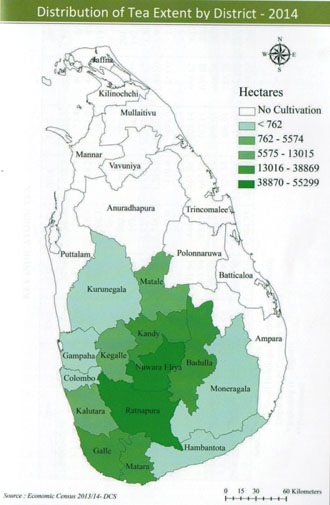The History of Tea in Ceylon
Tea plants were not part of the local flora of Sri Lanka until the early 19th century when several entrepreneurs used their estates as test plots. In 1839, Dr Wallich, the head of the botanical garden in Calcutta, sent several Assam tea plant seeds to the Peradeniya estates near Kandy. This initial consignment was followed by 250 plants, some of which went to an altitude of 6,500 feet. The Nuwara Eliya experiment produced excellent results. Seeds of Chinese tea plants were also planted in the Peradeniya nurseries although these yielded disappointing results, and Chinese plants were gradually abandoned in favour of the Assam variety that is now widely grown in Sri Lanka.
Tea cultivation remained a minor activity until the 1870s when a blight destroyed the coffee plantations which produced the island's main export crop. The entire local economy then shifted to tea. This rapid substitution owned a great deal to the initiative of a man named James Taylor.
Five years after he signed on as an assistant supervisor on a coffee plantation his employers, Harrison and Leake, impressed by the quality of his work, put Taylor in charge of the Loolecondera Estate and instructed him to experiment with tea plants. The Peradeniya nursery supplied him with his first seeds around 1860.
Taylor then set up the first tea "factory" on the island.
Historian D M Forrest quotes a description provided by Taylor's neighbour, planter E G Harding: "The factory was in the bungalow. The leaf was rolled on tables on the verandah by hand, i.e. from wrist to elbow, while the firing was done in chulas or clay stoves over charcoal fires, with wire trays to hold the leaf. The result was a delicious tea which we bought up locally at Rs 1.50 per lb."
In 1872, Taylor invented a machine for rolling leaves, and one year later sent 23 pounds of tea to Mincing Lane. From that point on Ceylon tea arrived regularly in London and Melbourne. Its success led to the opening of an auction market in Colombo in 1883, and to the founding of the Colombo Tea Traders' Association in 1894.
|
|
The arrival of Ceylon Tea
The 1884 and 1886 international expositions held in London introduced the British and foreigners to tea produced in the British Empire. But it was at the 1893 World's Fair in Chicago that Ceylon Tea made a tremendous hit - no less than one million packets were sold. Finally, at the Paris Exposition of 1900, visitors to the Sri Lanka pavilion discovered replica tea factories and the "five o-clock tea" that become so fashionable.
The PA supported this tea campaign by organising various publicity events. In 1891, Kaiser Wilhelm II, Czar Alexander III, Grand Duke Nicholas, the queen of Italy and Emperor Franz-Josef all received 60 chests of tea accompanied by an illustrated album on Ceylon.
The promotional policy was so effective that by the end of the 19th century, the word "tea" was no longer associated with China, but with Ceylon.
Tea growing regions
Today, tea is cultivated around 211,780 ha of land in Sri Lanka, which includes large company managed estates as well as private smallholdings.

|